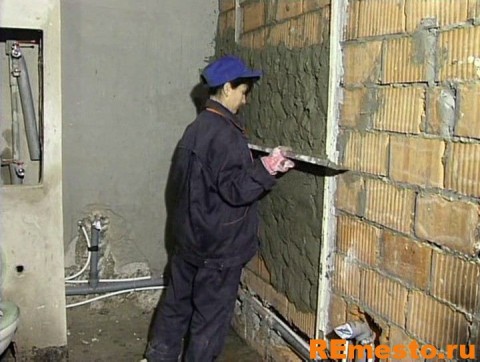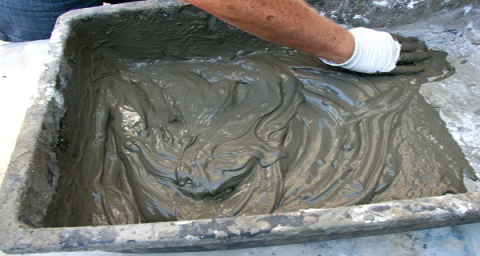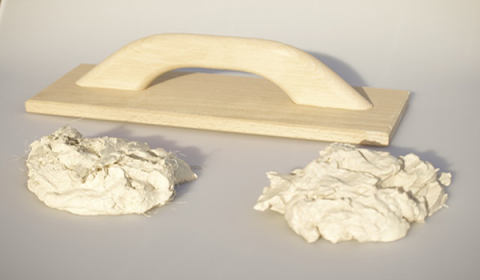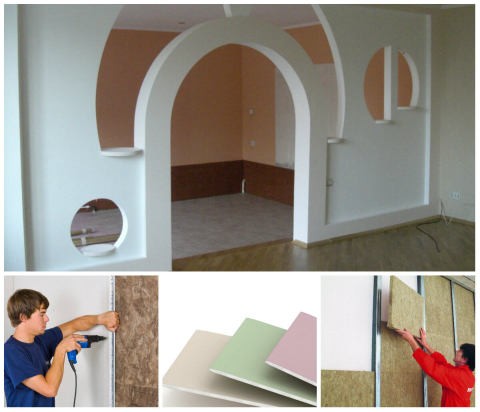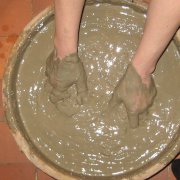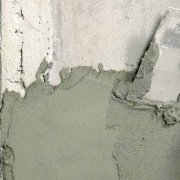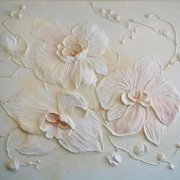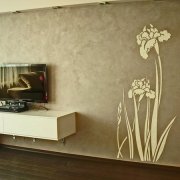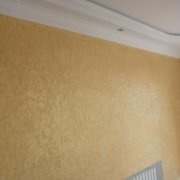How to choose plaster: consider which is better
What is better plaster or gypsum plaster? When conducting cosmetic or major repairs, plastering walls is an obligatory stage of wall decoration.
The effect of wallpapering, decorative plastering or painting will depend on the quality of the surface. But at the same time, you need to know which plaster is better for a particular type of wall surface. The article offers to get acquainted with the types of plaster for walls made of different materials.
The content of the article
Features and types of plaster mortars
The need to pre-level or plaster the walls or ceiling, very often arises before:
- By whitewashing (seeHow to whitewash the ceiling with water-based paint correctly).
- Painting.
- Wallpapering.
How to prepare the surface, what is the best plaster for closing cracks and joints, to even out even large irregularities, after which you get a smooth base?
Depending on the technology used, plaster can be:
- Cement-sand. It is used for rough work in wall decoration, in order to eliminate large defects in the applied plaster and in a monolithic wall. Such a solution is usually prepared ready.
Tip: When choosing cement, it is necessary to check its expiration date so that it is not expired, otherwise the setting of the mortar will be poor.
The solution for work on the outside or inside is different - for the external plaster, frost-resistant cement grades are used as part.
- Gypsum plaster. It is used for puttying on cement-sand mortar to eliminate remaining minor defects.
- Decorative. This is an alternative to wallpaper or other decorative coatings. It differs in various shades and various inclusions; decorative plasters used for facade work are separately produced.
How to prepare a cement based mortar
Cement mortar is most often used for wall decoration.
By consistency, it resembles a composition for masonry, but it also has the following features:
- Density.
- The ability to add other components and different plasticizers.
Tip: To achieve a quality solution, you need to use only pure sand filler. For this, before mixing the components, sand should be carefully sieved through a large mesh. This will remove stones, clay, debris from it.
Further instructions for kneading the composition offers:
- Mix dry with sand in the required proportions with cement (seeThe optimal ratio of cement and sand for plaster) Wherein:
- for exterior decoration it is better to take “M500” cement by mixing it with sand 1: 5 - five parts of sand are added to one part of cement;
- for plastering walls indoors - cement “M400” is mixed with sand in a ratio of 1: 4.
- The resulting mixture is mixed until uniform.
- Water is added.
- The composition is stirred until thick. Mixing can be performed in the trough, as in the photo, or in a construction mixer.
How to make a lime based solution
The bonding agent in this plaster is quality slaked lime.
To prepare the solution you need:
- Rub lime thoroughly until fine particles are obtained.
- Add sand and water to the container with lime powder crushed, constantly mixing everything.
- The result should be a homogeneous mass without lumps in density resembling a dough.
- Sand is added to this lime mass in the ratio:
- three parts of pure sand;
- one part of the lime mixture.
- Water is poured and stirred until a composition appears as thick sour cream.
How to make a clay based solution
The oldest and easiest solution to prepare is a clay-based mixture (seeClay plaster: composition and features of use) If previously only purely liquid clay was used that can withstand several rains, now components such as are added to the clay solution:
- Cement.
- Lime.
- Gypsum.
This plaster makes it stronger and more reliable, while maintaining accessibility in its preparation.
For this:
- The main component is prepared from the right amount of clean and dry clay, soaked for several hours in water.
- Sand is added to the wet clay in the ratio: from two to four parts of sand and one part of clay mass.
- Everything is well mixed.
How to prepare a gypsum-based solution
Gypsum dries very quickly. Stucco based on it is good to use for the final stages when leveling the walls. Such gypsum mixtures are excellent for finishing wooden surfaces, brick or concrete walls. There are several options for preparing a gypsum mixture.
To knead the gypsum cladding you will need:
- Three kilograms of chalk, crushed to dust.
- One kilogram of gypsum.
- After mixing, the resulting composition is poured with five percent wood glue, the amount of which depends on the required density of the plaster.
Joiner glue helps to form a homogeneous mass and slows down the drying process a little, but even in this form, gypsum plaster dries quickly enough. According to the second recipe with the prepared composition, it is better to process already painted surfaces or chipboard.
To do this, take:
- Two kilograms of gypsum.
- One kilogram of drying oil.
- 100 grams of desiccant.
All components are mixed and immediately quickly applied to the treated surface - the mixture dries instantly.
Which plaster is better
The main binders in plaster mortars can be:
- Cement.
- Lime.
- Clay.
- Gypsum.
- Complex mixtures.
At the same time, it is better to plaster concrete and brick walls with mixtures based on cement and lime with the addition of a small amount of cementitious materials.
For instance:
- The interior finish of brick and concrete surfaces is carried out with plaster compounds:
- calcareous;
- lime-clay. High viscosity from the cladding, the basis of which is clay, can be obtained by adding lime instead of cement. With this proportion: 0.3 parts of previously diluted lime and one part of clay. Three parts of sand are added to a homogeneous mass of clay and lime and everything is mixed;
- gypsum-gypsum. The combination of lime and gypsum makes the solution strong enough and quick-drying. Plaster contributes to the drying of the mixture after thirty minutes;
- cement-lime. To the plaster, the basis of which is cement, lime is added, diluted with water to a very liquid composition - two times denser than water.
- lime-clay-gypsum.
The density of the composition can be changed, which depends on the strength of the finished solution.
Tip: When adding more lime, the composition will have greater strength. But it should be borne in mind that with an increase in the strength of the plaster, the risk of cracking increases.
A plasticizing agent, which may be a liquid soap, can be added to the cement-lime composition, which will prevent the appearance of cracks.
- Exterior finish of the same surfaces is done:
- calcareous;
- cement-lime;
- cement-clay mixtures.
- To finish a wooden wall with your own hands, gypsum is added to any of these compounds. Solutions may be:
Tip: To facilitate the work, gypsum should not be added to the entire lime mixture at the same time, but only for a small portion. Make a lime-gypsum composition for every 25 minutes of work.
- gypsum-gypsum; To prepare the solution, 3 liters of lime mass are taken, one kilogram of gypsum is added to it. The composition is well mixed. Gypsum is diluted in water to moderate density and added to the lime mixture;
- clay-gypsum. In this mortar for plastering walls, gypsum is added to quickly dry the composition. At the same time, 0.25 fractions of gypsum are added to one part of clay, everything is well mixed and 3 parts of sand are added;
- clay-cement. To keep the clay stucco on the walls stronger, cement is added to it: 0.2 parts of cement and one part of clay. When preparing such a mixture, cement to clay should be added to the sand. Otherwise, the concrete mixer will not help stir the solution;
- lime-clay-gypsum.
Tip: If necessary, plaster the walls, the solution is best prepared independently, and not purchase it in the store. This will give a greater degree of confidence that the material will be of high quality.
Which is better and cheaper - stucco or drywall
Everyone wants the repair price to be lower and the quality to be better. Therefore, the question arises, what is better gyro or plaster?
Using drywall allows you to realize a variety of fantasies, for example, to do:
- Half-cooked.
- Rack.
- Bas-relief.
But in this case, when decorating the premises with drywall, its cost, unlike plaster, will be significantly higher.
Wherein:
- The volume of the room is reduced.
- Additionally, the frame is made of a metal profile or wooden battens.
- The electrical wiring is performed again, which will require the involvement of a specialist.
- Drywall requires two coats of gypsum-based plaster.
- The surface is then finished with a decorative coating.
If we confine ourselves only to rough plastering of the walls, and then their puttying, all these stages can be avoided, which means reducing the cost of repairing the room.
How and what to complete the decoration of the room, everyone decides for himself. It all depends on the preferences and material capabilities of the owner. The video in this article will give general recommendations that should be considered when repairing your home.
